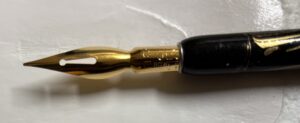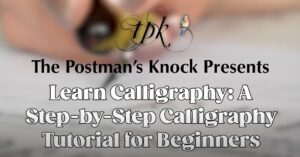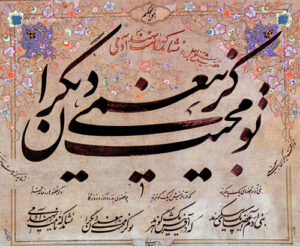My First Steps into Blending Persian and Western Styles
Why Blend Persian and Western Calligraphy?
What excites me most about this journey is the opportunity to see how two distinct traditions can intersect and inspire each other. Persian calligraphy, with its continuous, flowing lines, feels almost like poetry in motion, while Western styles tend to be more structured and segmented. The challenge (and the fun) lies in merging these styles, discovering how each tradition can inform the other, and ultimately finding my own voice as a calligrapher.
The First Step: Gathering the Tools
Since Persian calligraphy relies on traditional tools like the qalam (reed pen), switching to Western tools like brush pens, pointed nibs, and markers felt like a big leap. I took some time to look for the materials I needed:
- a beautiful, gold marbled, straight pen holder,
- a gold plated No.513EF pointed pen nib,

- a super pigmented acrylic ink(black),
- a jar of pen cleaner and

- practice guides for styles like Copperplate and Modern calligraphy. Amongst tens of various resources and coaches, I found a great Youtuber that explains calligraphy step by step called The Postman’s Knock.

It’s fascinating how these tools allow for a different kind of pressure and control compared to the reed pens I’m used to.
Diving Into Practice: Bridging Two Worlds
To start, I focused on warming up with drills to get a feel for the Western tools. The pressure dynamics are quite different—the light, sweeping strokes in Persian calligraphy require a delicate hand, while Western styles like Copperplate demand precision and controlled consistency. I practiced individual letters first, slowly working my way up to words, all while alternating between Persian and Western calligraphy styles. This gave me a chance to observe how one influenced the other and appreciate the contrasts.
Reflections: A Beautiful Contrast
So far, I’ve been struck by how differently these two traditions approach form. Persian calligraphy is all about fluidity and the continuation of motion, whereas Western scripts are often more segmented, relying on crisp, defined angles. But I’m starting to see where they can complement each other—perhaps by incorporating the elegant loops of Persian script into the structured forms of Gothic lettering, or blending the delicate curves of Copperplate with the boldness of Persian flourishes.


Looking Ahead: My Goal for the Project
I’m excited about creating a final project that blends both styles. I envision a quote, perhaps bilingual, that showcases the flowing beauty of Persian calligraphy alongside the structured elegance of Western calligraphy. But for now, I’m still in the practice phase, focusing on improving my consistency, spacing, and mastering each stroke.
The Journey Continues
As I continue to refine my technique, I’m eager to share my progress and learn from others. Calligraphy is a constant journey of improvement, and I know there will be plenty of challenges along the way. But I’m excited to see how these first steps evolve into something uniquely mine, blending the old and the new, the structured and the free.
Hello!
This is such a cool and unique idea! I honestly know very little about calligraphy, but reading about what you explained here already has me hooked. I love that you took something you already know in a certain way and chose to explore how it is done in a different part of the world. It definitely seems very difficult. I cannot wait to see how you practice this skill and what you choose to do as your end product!
Hello Camryn!
Thank you very much for your supportive comment! Well, the point is that this blend comes with both similarities and differences which make the project more intriguing! I am also looking forward to exploring this project further.
This is so exciting! I’ve always loved watching videos of people doing calligraphy and looking at the fancy script. I’ve been debating buying a calligraphy set for a friend for a while now but I had no idea where to look. After looking at your list and researching them it’s helped me decide what to get them! I’m so invested on your journey! Good luck!